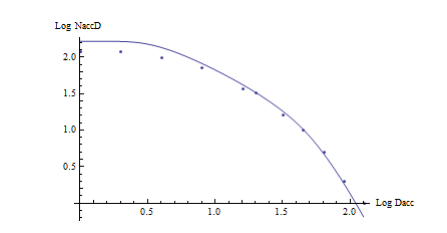Mars Astronauts Likely to Witness 1 Megaton Asteroid Impacts
Asteroid impacts are among the most feared of natural catastrophes. So estimating the risk they pose to humanity is an important task.

One method is to look at the number of impacts in the past and use this as a guide to the future. This isn’t entirely straightforward since the distribution of crater sizes we see today depends not only on the rate of impact in the past but also on the rate of disappearance via processes such as erosion, tectonic changes, obliteration by other craters and so on.
Nevertheless, various groups have measured the distribution of crater sizes and come up with estimates of future impact probabilities.
Today. William Bruckman and pals at the University of Puerto Rico at Humacao do exactly this kind of analysis but with a twist. They derive impact probabilities for Earth but also for Mars. Their conclusion is that astronauts visiting Mars for just a few years are likely to witness a significant asteroid impact.
Bruckman and co’s work is one of mathematical modelling and testing. These guys have created a model that describes the rate of impact on Earth and tested it against the existing data.
Their model suggests that Tunguska-type events of around 10 megatons should occur roughly once a century and smaller 1 megaton events once every 15 years. They say that both these predictions are compatible with crater counts and most other estimates.
Emboldened by this success, they apply the same model to Mars, where impact rates are likely to be higher because of its proximity to the asteroid belt. Here’s the interesting part: these guys calcaulte that Mars experiences a 1 megaton event every three years.
That’s significant because future missions to Mars may well last several years. “We expect that Mars visitors spending a few years there will have a high probability of witnessing a megaton-type meteorite impact.” they say.
That’s could have an important impact on any mission. “These impacts are likely to cause more damage on the surface than on our planet, due to the much lower atmospheric Martian density,” they conclude.
The one problem of course is how this squares with the actual experience of exploring Mars using robotic landers and rovers. These missions have together clocked up several decades on the surface. It’s not at all clear that any of them have been hampered by, or even noticed, a 1-megaton asteroid impact.
Nevertheless, these kind of predictions require further study.
Any visitors to Mars will be no strangers to danger, of course. A mission would involve the significant risk of launch, a landing on a foreign planet and a launch home again, plus the intense radiation throughout both legs of journey and the time on the Red Planet. As if that weren’t enough, they’ll now have to worry about the possibility of a megaton asteriod impact.
All the more reason, if any were needed, to rely on the cheaper, safer, more capable efforts of robots for the foreseeable future of Martian exploration.
Ref: arxiv.org/abs/1212.3273: Earth and Mars Crater-Size Frequency Distribution and Impact Rates: Theoretical and Observational Analysis
Keep Reading
Most Popular
Large language models can do jaw-dropping things. But nobody knows exactly why.
And that's a problem. Figuring it out is one of the biggest scientific puzzles of our time and a crucial step towards controlling more powerful future models.
The problem with plug-in hybrids? Their drivers.
Plug-in hybrids are often sold as a transition to EVs, but new data from Europe shows we’re still underestimating the emissions they produce.
Google DeepMind’s new generative model makes Super Mario–like games from scratch
Genie learns how to control games by watching hours and hours of video. It could help train next-gen robots too.
How scientists traced a mysterious covid case back to six toilets
When wastewater surveillance turns into a hunt for a single infected individual, the ethics get tricky.
Stay connected
Get the latest updates from
MIT Technology Review
Discover special offers, top stories, upcoming events, and more.